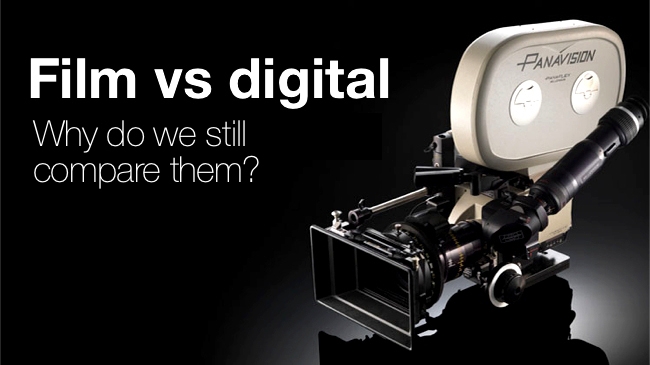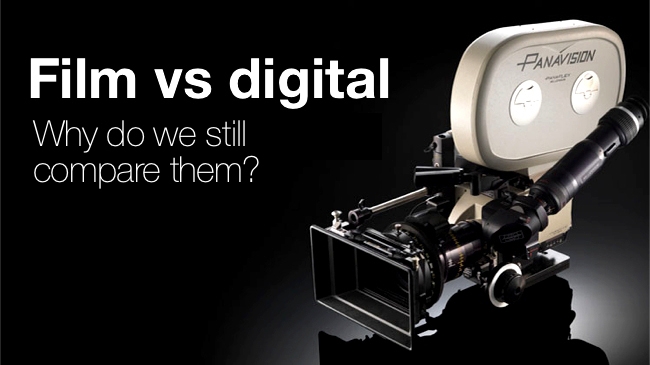
 Why do we still compare film with digital
Why do we still compare film with digital
Digital video can now demonstrably beat film in every way. So why do we keep comparing the two?
The big chip camera revolution came about from a demand from users for a much more film like image. If you were a low budget film producer the barriers to shooting 35mm film were rather large, and nothing screamed low budget more than the noisy, highly compressed and overly “enhanced” digital looking image from a 1/3” camcorder.
I used to push for more adjustments to be made available in cameras. It used to be that detail functions, and colour matrix control were part of a black art that was solely the preserve of video engineers.
When I first started writing about such functions and what they did there was hardly any information available on the internet about it. Certainly nobody else was writing about them and the advantages they could bring in a way that most people could understand. I took my lead from Alan Roberts who used to publish his findings on the performance of cameras and how to set them up to look more film like.
Such functions are now available on even lower end equipment, but more importantly many modern big chip cameras can resolve so much detail and have such high performance, or the ability to capture raw footage, that often these functions are a bit of an aside.
Widely available to anyone who wants it
As I have said in other articles, the same type of kit is now quite widely available to anyone who wants it, from amateurs to hardened professionals. Cameras at the lower end of the spectrum such as the Sony FS700 can produce a 4K raw picture that rivals even the highest end gear. You need to be a pixel peeper or display things side by side on a very large grade 1 monitor to spot the difference.
It was only recently that I discovered that the Indonesian film “The Raid” was shot using Panasonic AF101’s. Before I was told this fact I wouldn’t have considered what it was shot on, and had just assumed that it was film. I should have known better of course because Gareth Evans shot his previous feature on an ENG camera with a 35mm ground glass adaptor. His latest movie “The Raid 2” was shot using Red cameras.
Think about that for a moment. “The Raid 2” is actually still a very low budget film. A fantastic film yes, but very low budget, and yet it was shot using the same base camera as Peter Jackson's “The Hobbit” trilogy. In turn there are corporate video producers making productions for the web who are also using Red Epic cameras too.
Many productions - same base camera
Never before have all three tiers of production so readily used the same base camera. The fact that “The Raid 2” could just as easily have been shot using a Sony FS700 if they had so wanted without too much detriment to the picture is even more amazing.
So why are we still stuck in a hangover of comparing video to film? Film is most certainly in its death throes. It has been for a long time, but still clings on by the tips of its fingers. Like a bad actor who wishes to milk out their death scene to the max it refuses to die off completely. Yet despite the fact that newer cameras are now equalling or even out performing film in terms of latitude, resolution, and noise, we are still for some reason compare our images to it.
Why does film have such a hold on us? Lots of people will cite the organic nature of film. Much doe eyed reflection on how amazing film is tends to come from sepia tinted nostalgia. I have been told stories of how amazing it was to hold film and that somehow it gave a truly personal connection to the production. Interesting... Personally I feel that we should move beyond comparing our images to film.
Particularly when your camera is recording a linear raw image with a 14-stop range, any highlight roll off when viewed on a normal screen in the final production will be the result of your colourist doing their work. Seeing people “expertly” comment on the highlight roll off from a particular camera when they are viewing graded footage is simply a nonsense. Instead of comparing such aspects of an image to film we should simply be judging whether or not it is a pleasing picture.
I don’t know about you, but when I am engaged in watching a movie I am not looking at highlights and thinking to myself about how pleasing the roll off is. If I was I would consider that production to be incredibly dull!
Nonsense to take a supremely clean image and then slap on a filter that adds noise and grain?
The draw of film goes still further. In the quest to make images more film like there are many filters for NLEs that claim to make your image look like particular film stocks. Is it not a bit of a nonsense to take a supremely clean image from, say, a Sony F55, and then slap on a filter that adds noise and grain?
Okay, I admit that there are instances where you might want to do this. Simulating old footage for example, or going for a gritty Saving Private Ryan or Children of Men look.
However I have seen reviews of cameras, which state gushingly how little noise there is in the picture, and then the very same reviewer goes on to produce a montage of shots of some atmospheric planks of wood on a beach or something that has been “graded” with a film look plug in with added noise/grain.
That there is such a burgeoning market out there for expensive filters that effectively set out to degrade all the advantages of your clean digital image is a mystery to me. By all means use such filters if you really feel a need to, but please don’t boast to me about the resolution and noise performance of your camera in the same breath as mentioning that you use such things on a regular basis!
Inferiority complex?
Does the video world still have such an inferiority complex that it feels the need to simulate all the defects of an obsolete format? Do you think your audience actually cares about the minutiae of tiny grain patterns that you so desperately seek? I took a look at one of the more popular film stock filters. I would be outright lying if I told you that I could tell you the difference between the different Kodak and Fuji grain patterns that they so lovingly set out to recreate.
When it comes to the quality of image I now believe that far from comparing video to film, we should instead be comparing film to current video cameras, if we must make such a comparison in the first place any more.
Certainly in terms of being able to be dumped in a chicken shed for 100 years and then recovered and watched, film has the edge over digital. It cannot be denied that film has superior archival abilities even if the resultant picture might be highly degraded. At least a picture is still visible, and it is possible to perform digital restoration on it.
In general however, we should move beyond comparing video to film. Film has had its day. It is a relic, and its long held beacon of capabilities compared to digital have long since been eroded.
At one time I would have killed to have had the opportunity to shoot 35mm film. Now I wouldn’t even use it if you held a gun to my head! It would offer me no advantages whatsoever.
I realise of course that there will be diehards out there who completely disagree with me. They will tell me how new ultra low grain film stocks have been developed for various purposes, and how master quality film is the bees knees. I’m not listening. Film does not have the performance advantage that it once had, and it is as inaccessible as ever for people who don’t work for a film studio.
Now can we please nail that coffin shut for good?
Tags: Technology


Comments